A cardigan is a model of a women's knitted sweater. They differ from each other in color, patterns and type of silhouette. To learn how to knit different styles, you need to study them diagrams and descriptions, find out what threads and knitting needles you will need for the work.
Choosing yarn for knitting a cardigan
When purchasing yarn for a women's cardigan, you need to pay attention to its following characteristics:
- practicality;
- quality;
- wear resistance.
Cardigans can be light and thin, such models are intended for wearing on cool summer evenings. Most often, silk, viscose, and linen are used for knitting these items. More insulated options are suitable for the off-season, sometimes even with a sewn-in lining. Such cardigans are worn as outerwear, instead of a coat.
These items must be resistant to moisture and temperature changes, so acrylic, wool with synthetic additives and Shetlen yarn are suitable for knitting. Winter models are mainly made of wool. The items are voluminous, soft and warm. The table shows the most popular types of wool yarn that are suitable for knitting winter cardigans.

| Merino | The soft and light thread feels pleasant on the skin. It is used for knitting voluminous cardigans and children's winter clothes. |
| Shetland | Suitable for off-season models. The thread is wear-resistant and almost does not form pellets. |
| Cashmere | Used for knitting winter models, but 100% material quickly loses shape. Therefore, the threads are sold in a diluted form (50% acrylic). |
| Mohair | Like cashmere, it is sold only in combination with wool or acrylic. Suitable for knitting spring, summer and winter cardigans. |
| Angora | A soft, thin thread. Most often, it is used to create summer and spring models. |
| Alpaca | Suitable for cardigans without complex patterns, as it tends to stretch in the shoulders under the weight of the entire product. |
In addition to practicality, it is important to pay attention to quality. The thread in the skein must be of the same thickness and evenly colored. There should be no knots or delamination on it.
Before buying, you need to examine all the balls well. Before you start knitting, you will need to make a 10x10 cm sample and subject it to various tests. Wash to check if the yarn is shedding, steam and find out how much the material can shrink.
To increase wear resistance, it is recommended to buy mixed materials, such as wool with acrylic. If you knit a cardigan from 100% wool thread, it will quickly roll and stretch, and such yarn is more expensive.
Knitting from pure acrylic is also not worth it, although this material is considered an artificial analogue of wool, things made from it look very cheap. In a ratio of 50x50 or 80x20, the materials complement each other well and a stronger and more beautiful thread is obtained.
Selecting spokes
Women's cardigan models (their patterns and descriptions of how to work with them are presented in the article) are knitted with a crochet hook and knitting needles.
Knitting needles are a more versatile tool, as they allow you to create a solid canvas, voluminous or openwork patterns. It is important that the tool is smooth, light and fits comfortably in your hands. Plastic and aluminum knitting needles are suitable for winter models, and bamboo for summer ones.
To make the loops denser, the tool should be 1-2 times thinner than the thread. The numbering of the tools corresponds to their diameter, for example, knitting needle No. 2 is 2 mm thick. You can also determine the approximate thickness of the thread, the narrower it is, the longer it is in the skein.
You can use this table as a guide:
| Thread length per 100g | Spoke number |
| 800 m | 1.5-3 mm |
| 400 m | 1-3.5 mm |
| 300 m | 3-4.5 mm |
| 200 m | 4-5 mm |
| 150 m | 5-6 mm |
| 100 m | 6-8 mm |
| 50 and less | 9-15 mm |
The knitting needles differ from each other, each type is intended for knitting different elements of the product.
For cardigans you will need the following tools:
- straight knitting needles with stoppers – to create an even fabric;
- circular knitting needles – for knitting sleeves and collars;
- auxiliary (zigzag) – for pockets and patterns.
Beginners can use only straight tools, but for knitting complex models you will need the whole set.
What patterns are used in knitting cardigans
A cardigan with knitting needles (diagrams and description for women are presented further in the article) can be knitted with garter stitch, choosing a simple style, or, on the contrary, decorate the product with beautiful patterns and choose an unusual cut.

The most popular voluminous patterns for cardigans:
- braids;
- spikelets;
- cones;
- cross knitting;
- openwork;
- paths;
- locks.
And also various geometric and floral patterns. The drawing can be not only textured, but also colored.
The most common color solutions:
- Vertical, diagonal and horizontal stripes of yarn in 2 or more colors.
- A gradient of 4 threads of the same color spectrum, where each is 1 tone lighter than the other.
- Floral patterns made up of individually linked blocks.
- Chess order.
Experienced craftswomen can knit exclusive items using threads of different shades to create appliqués, designs and inscriptions.
Pattern
Most often, a basic drawing of a straight dress with sleeves, without darts, is used for cardigan patterns.
To build it you will need to take the following measurements:
- Chest circumference.
- Waist circumference.
- Hip circumference.
- Distance from the back to the waist.
- Length of the cardigan.
- Chest height.
- Front waist length.
Next, the basic drawing needs to be "reworked" a little. For example, the simplest model is taken: a long cardigan with sleeves, without a belt, with a wrap and small slits along the side seam at the bottom.
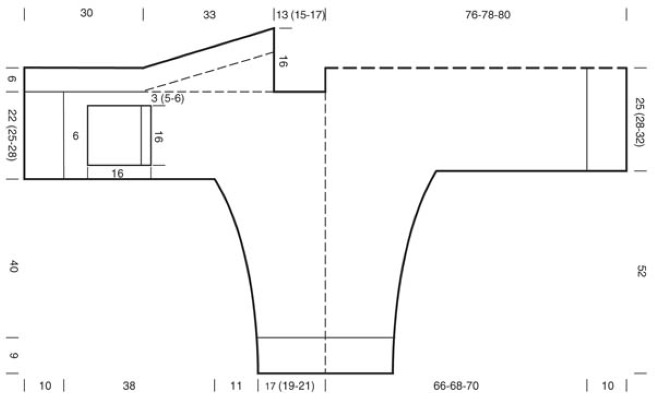
Instructions:
- From the extreme point of the shoulder, you need to step back 2 cm up on the back and front parts. The shoulder line needs to be extended by 5 cm, and the armhole line needs to be redrawed. It can be increased or decreased, depending on the needlewoman's preferences.
- The sleeve roll-up needs to be slightly reduced, by about 5 cm, and its width adjusted. As a result, the length of the roll-up should be equal to the length of the armhole.
- The side line will need to be made smooth, decreasing 3-4 cm at the top. The cuts on the sides need to be marked with dots. Their length can be from 10 to 20 cm.
In the finished version, you can decorate the sides with a 3 cm wide elastic band or leave it as is.
Basic course of knitting with large loops for beginners. Scheme and description
A knitted cardigan (patterns and description for women are presented further in the article) can be decorated with a simple garter stitch using the example pattern above. The description shows a model of size 42-44. The only thing you need to add is pockets. For knitting you will need thick yarn and circular knitting needles No. 12, 80 cm and 120 cm long.
Left shelf and half of the left sleeve
Knitting starts from the left shelf and half of the sleeve.
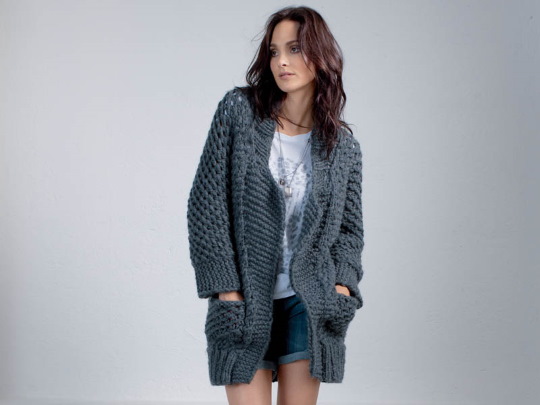
To do this you will need:
- Take 80 cm knitting needles and knit 25 loops.
- Knit 12 rows and in the last row increase by 1 loop.
- When the fabric reaches 38 cm from the beginning to the last knitted row, you need to add a loop for the sleeve on the right. Then increases should be made on every 2 rows.
- Then the increases are made 1 time, adding 2, 3, 6, 10 and 20 loops at once. Each time the loops need to be picked up from the free thread and attached to the general fabric.
- Then on the 8th loop you need to cast on another 80 loops for the cuff.
- After 33 cm from the last increase, you will need to close 15 loops of the front strip. You will get 65 loops.
After 17 cm from the start of knitting the sleeve, the loops should be transferred to an auxiliary thread.
Right shelf and half of the right sleeve
Since this cardigan is knit in garter stitch, it looks the same on both sides.
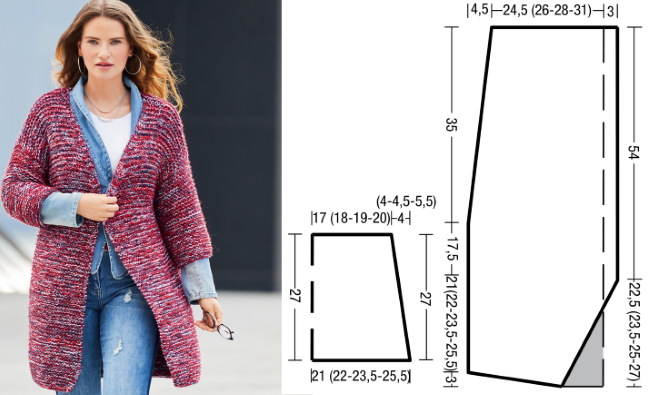
The right shelf and half of the right sleeve should be knitted in the same way as the parts on the left side. When both shelves are knitted, they should be put aside and start knitting the back and halves of the sleeves.
Back and halves of both sleeves
How to knit:
- The loops of the left sleeve should be transferred to long circular knitting needles.
- For the neck, knit 9 loops and transfer the loops from the right sleeve to the knitting needles. You should get 139 loops.
- Next, knit upwards on all loops, attaching the edge to the main fabric.
- The cuffs continue to be knitted in garter stitch after the edge stitches for 8 loops.
- When 34 cm of knitting is added from the edge of the sleeve, you need to decrease the loops. First, close 20 loops on both sides, and then 1 time each of 10, 6, 3, 2 and 1 more. You should get 45 loops.
Next, the back is knitted to the very bottom and the knitting is closed.
Pockets
The pockets will be square, so cast on 15 stitches on short knitting needles and knit 14 cm of fabric, then close the knitting. The second pocket is created in the same way.
Assembly
When all the parts are ready, they need to be assembled into 1 whole product.
How to do it:
- You need to knit 16 loops along the edges of the shelves, and 10 loops along the edge of the neck.
- In the 1st row, knit 24 loops, then make a yarn over and turn. Knit 8 loops in the other direction. Make a yarn over again and turn, knit another 10 loops, and then once again turn the loop after the yarn over and knit 14 loops.
- In this way, you need to knit all the loops up to the collar. The thread is fixed and broken off.
- The halves of the sleeves are connected using a running stitch.
All that remains is to sew the pockets to both shelves at the same distance from the edge of the shelves.
Beautiful knitted women's cardigans. New styles, knitting patterns features
Cardigans with knitting needles (patterns and descriptions for women will be more understandable if you know the word designations of loops) are knitted in different styles. The knitting principle is based on the simplest model (left and right shelf, sleeves, back), with the exception of some styles with hoods, or consisting of a single piece of fabric.
To make the cardigan more beautiful, needlewomen use 1 or several patterns, both textured and colored.
Below are more detailed descriptions of knitting different patterns and additional details for fashionable cardigans.
With braids and buttons
This cardigan consists of a left and right shelf, sleeves and a back. Large buttons should be sewn along the edge of the left shelf, and loops of a suitable diameter should be knitted on the right side.
The braid pattern is most often located on the back and on the shelves. You can knit groups of simple braids of 3-4 pieces at the same distance from each other or make a pattern across the entire fabric by knitting 1 braid at a time.
How to knit the simplest pattern:
- When the lower elastic band on the shelf or back is knitted, you need to knit 1 row of garter stitch. Then determine the place of the pattern and count 14 loops for it. 12 of them will be needed to make the pattern and background, and the remaining 2 are edge loops.
- Now 2 loops are knitted purlwise, and 8 are knitted. The remaining 4 loops are knitted purlwise. Thus, 4 rows are formed.
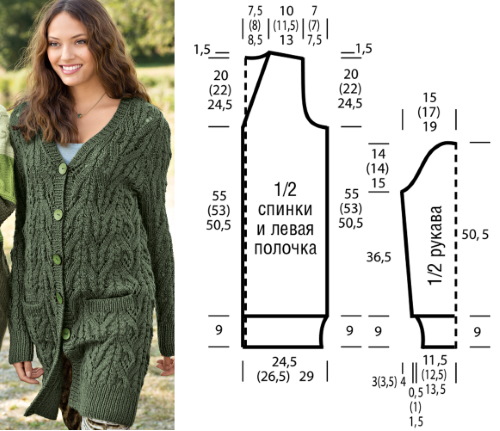
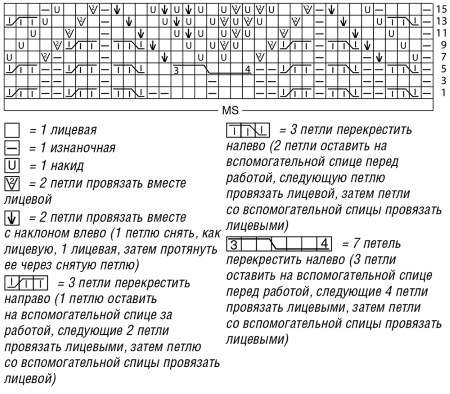
- On the next, 5th row, the formation of the braid begins: 2 purl, 4 front, drop onto an additional knitting needle and move forward, knit 4 front, return the remaining loops to the working knitting needle and knit them. The remaining 2 - purl. Then, knit like this until the 12th row.
From row 16, repeat step 5 and knit according to the instructions to the end. The thickness and volume of the braid depends on the yarn. Before making a cardigan, you need to knit several braids of varying complexity on a sample. To determine which option will look better.
Striped with wide sleeves and pockets
For this product, you will have to change the basic drawing, increasing the width of the sleeve and its slope, in accordance with the measurements taken. The striped pattern is obtained by simply replacing 1 thread color with another.
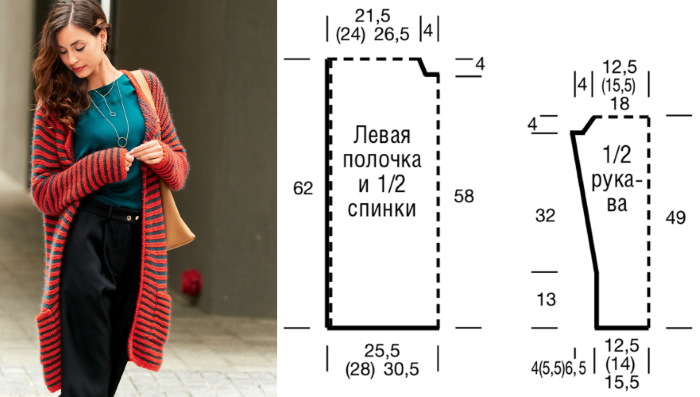
It is important that the threads are of the same thickness and preferably made of the same material as the main ones. The thickness of the stripes varies from 0.5 to 7 cm. They can be multi-colored, monochromatic, or differ from each other by 1-2 tones. The main thing is to choose the right color scheme so that all the shades match each other.
This pattern is suitable for garter stitch and stockinette stitch. It is not recommended to combine stripes and textured ornament. Such a combination will spoil the appearance of the product.
Mohair with hood
This item can be knitted in garter stitch or with patterns.
How to knit a hood:
- Sew the edges of the knitted product from the right side 15 cm, along the upper edge of the sleeves and neckline.
- On the same section, cast on 150 stitches and knit a hood using garter stitch.
- The loops need to be decreased 45 times, every 2nd row by 1 piece, then close the remaining 60 loops.
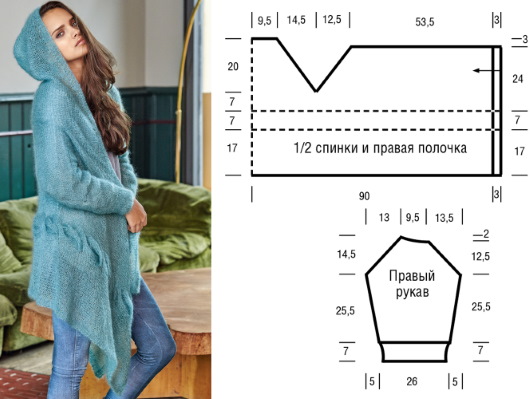
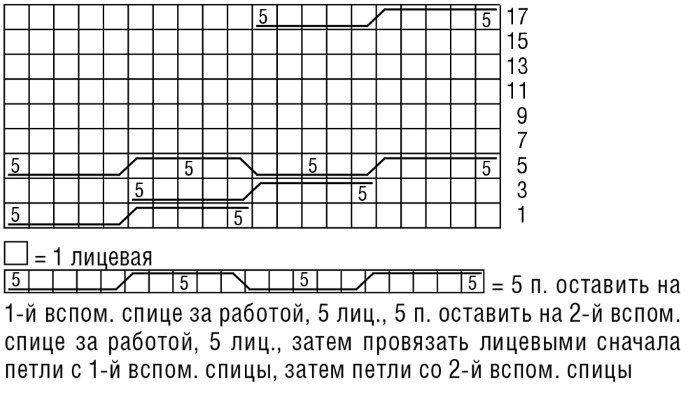
When assembling, the hood is sewn together, folding it in half at the top.
Openwork
The simplest openwork pattern is considered to be a mesh. It is suitable for summer cardigans made of viscose or bamboo yarn.
How to knit a mesh:
- Cast on an odd number of stitches and knit the first row in garter stitch.
- Remove the edge loop. The next 2 need to be knitted together with the front one, make 1 yarn over. Knit in this way until the end of the row. And all the other subsequent rows from the wrong side.


- The front rows are knitted in the same way, but with a change in sequence.
The result is a fabric with small round holes.
Cross-knitting
This cardigan is knitted with a 3-ply yarn. To create an interesting pattern, you should choose yarn of different colors. You can use any pattern as a basis.
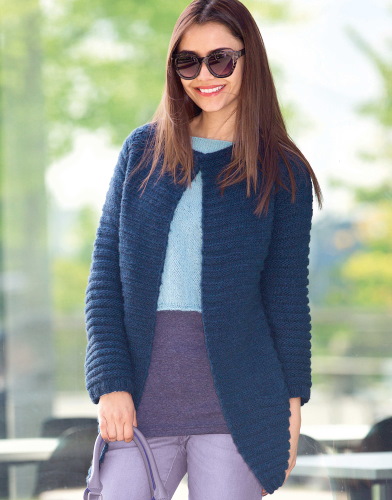
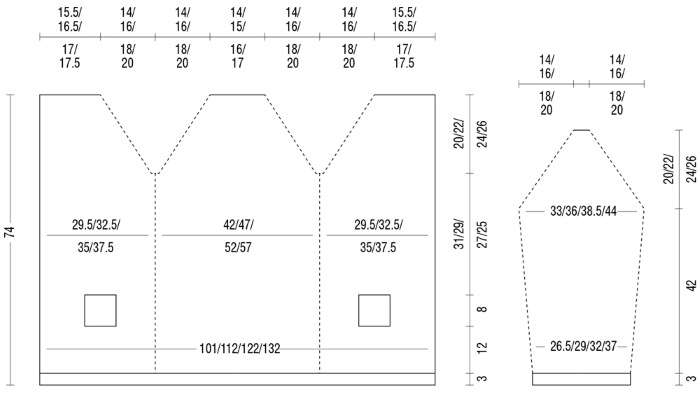
For transverse ribs, alternately knit 2 rows of front loops, then 2 rows of back loops.
Long with pockets and dropped armhole
To knit such a model, you will need to adjust the basic drawing of a straight silhouette. The armhole needs to be made V-shaped, and the length of the product increased by 10 cm.
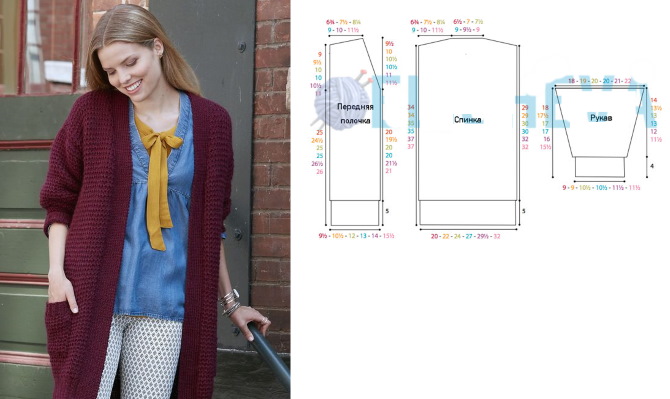
The pockets should be rectangular and large. The edges of the shelves are decorated with an elastic band. Most often, such a cardigan is knitted with a garter stitch, but it can be diversified with a textured pattern.
Tapered at the bottom
Knitted cardigan (diagrams and descriptions for women are presented in basic variations, patterns can be changed at your discretion) tapered at the bottom is based on the basic pattern, but you will need to draw the back slightly wider by 5-6 cm.
The slope of the sleeves is slightly raised towards the collar, and the shelves are made semicircular at the bottom. The model can be with or without pockets. Most often, tapered styles are knitted with a ribbed pattern.
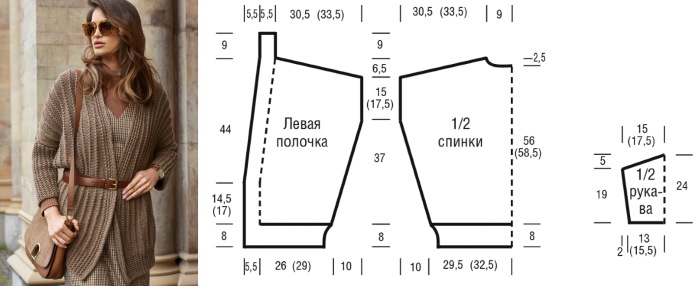
How to knit it:
- It is necessary to cast on loops, the number of which will be a multiple of 3.
- The edge loop is removed and purl loops are knitted, leaving 1 edge loop.
- The next row is started again with an edge loop. Then the knitting needle is inserted between the 1st and 2nd loops and 1 front loop is pulled out and a yarn is made. 3 loops are knitted together with a tilt to the right side.
Steps 1 and 2 must be repeated until the end of the entire knitting.
Summer crop
This is a shortened model. It is best to knit it with garter stitch or openwork mesh from mohair or viscose.
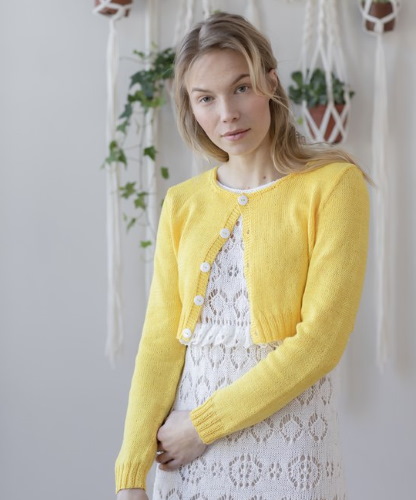
The top of the basic pattern fits perfectly, but the bottom needs to be shortened to the waistline, and the sleeves and fronts should be tied with an elastic band 2-4 cm wide.
Oversized cardigan coat
The model is knitted according to the basic pattern of a straight silhouette, but a collar with turn-ups and lapels is added or it is made long, like a shawl collar.

You will also need to knit a wide belt and make cuffs on the sleeves.
With a mesh pattern of broaches
This pattern is suitable for summer and spring models. The best mesh is made from viscose, bamboo, mixed acrylic, with angora.
How to knit the pattern:
- In the 1st row, make a knit stitch, draw through, then yarn over and knit 4 knit stitches.
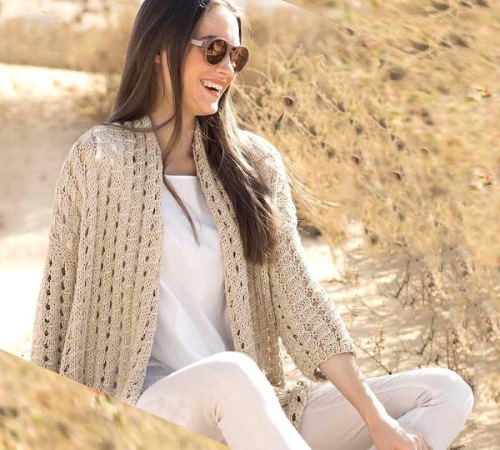
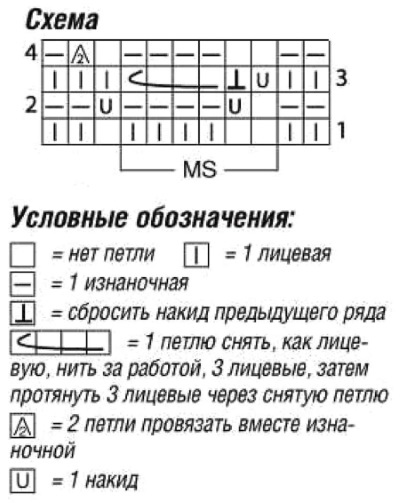

- The next row and all other even rows should be knitted with purl stitches.
- Then you will need to knit 2 front loops at once, make a yarn over. Knit 1 more loop, make a yarn over again and knit 2 front loops.
- Now 4 knits, then a yarn over. Then slip 1 knit, make a yarn over. Pull through, then 2 knits again, pull through the slipped loop and finish the row with a yarn over and 1 knit.
Then all points are repeated.
With Indian ornament
Indian patterns can be different:
- jagged stripes;
- triangles;
- diamonds;
- arcs and rectangles.
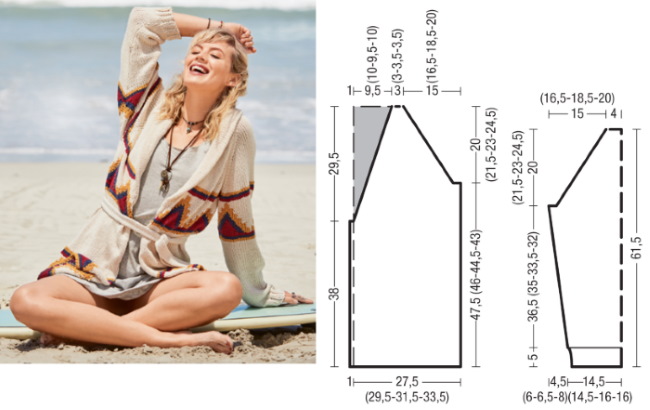

It is important to choose the right color scheme here. If the main color is dark, then the patterns should be black, white and brown. For light cardigans, you can use yellow, red, white yarn. The pattern looks good when knitted with a smooth, non-fluffy thread.
In boho style
The classic version of the model is a long shawl collar, grey colour and blue pattern on the lower part of the sleeves, back and both fronts.

The edges of the product are decorated with short gray fringe. The pattern looks best in garter and stocking stitch.
In Chanel style
This is a retro-style cardigan. The length of the product is up to the hips, a round neckline without a collar, and narrow sleeves. Most often, this model is knitted from merino, viscose and cotton. The cardigan has clear lines, so it complements a business look well.
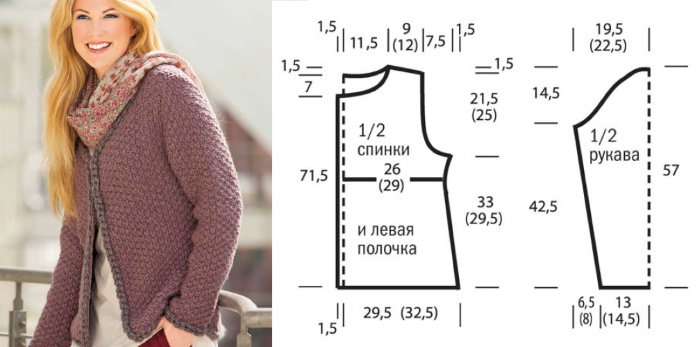
It can be knitted with a garter stitch or with small patterns added, such as stripes, flowers or spikelets. It is considered that the model suits any type of figure.
With honeycomb pattern
Thanks to this pattern, the cardigan acquires elasticity. Honeycombs allow the product to retain heat well, so they are knitted on winter cardigans made of wool.
How to knit honeycomb:
- The edge loop is removed and 1 front loop is knitted. Remove 1 loop with a yarn over, as if it were a purl. The row is knitted to the end, ending with an edge loop.
- Edge loop, knit before yarn over is removed as purl. Thread should be passed behind yarn over. Knit 1 loop. Repeat to end of row.

- After the edge loop, remove with yarn over as if it were a purl. They are knitted together and repeated to the end. Before the last edge loop, remove 1 loop with yarn over as if it were a purl.
- 1 front stitch through the yarn over is removed as if it were a purl stitch and 1 front stitch is knitted until the end of the row.
- Yarn over stitches are knitted together. Slip 1 yarn over stitch as if to purl. Repeat to end of row.
You will get a dense grid of diamonds.
From Drops
Model with raglan sleeves and a round, shallow neckline. There are short slits on the sides. It is recommended to knit with garter stitch with ribbing on the cuffs, using Drops Nepal yarn (65% wool, 35% alpaca) and knitting needles No. 5.
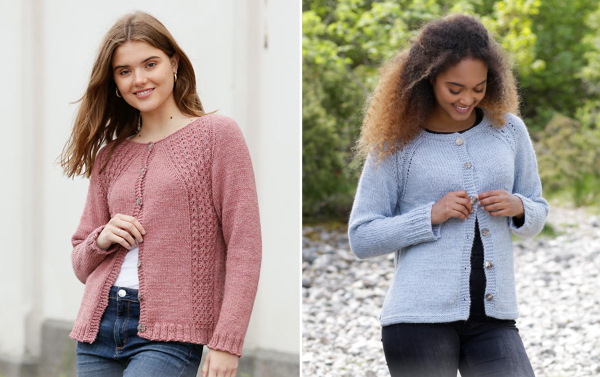
A basic drawing of a straight silhouette is suitable for the pattern. Where it will be necessary to adjust the slope of the sleeves.
Gladiola with rich Aran pattern and cones
This model is knitted from warm woolen threads of medium thickness. The pattern consists of arans with cones and pearl knitting, which is done like this: 1 front, 1 back to the end of the row. For arans and cones, a schematic diagram is needed.

The pattern is placed on the sleeves and on the upper part of the back and both fronts. The model is cut out according to the basic pattern of a straight silhouette, changing the rounded collar to a "shawl".
In the style of Lalo with a spikelet pattern
This is one of the most extravagant models. The spikelet pattern turns out lush and voluminous. This style looks good on any type of female figure. Light and soft threads are required for work. Experienced craftswomen recommend using Lanagold Plus yarn (acrylic 51% and wool 49%).
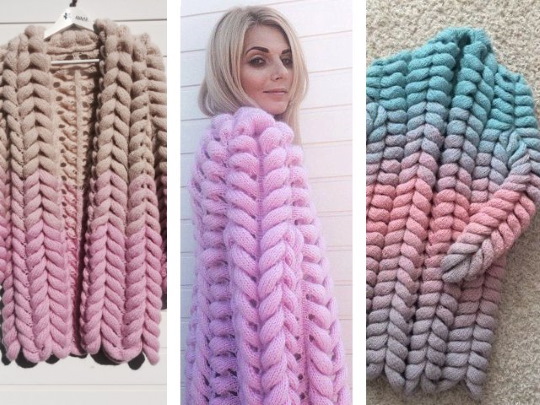
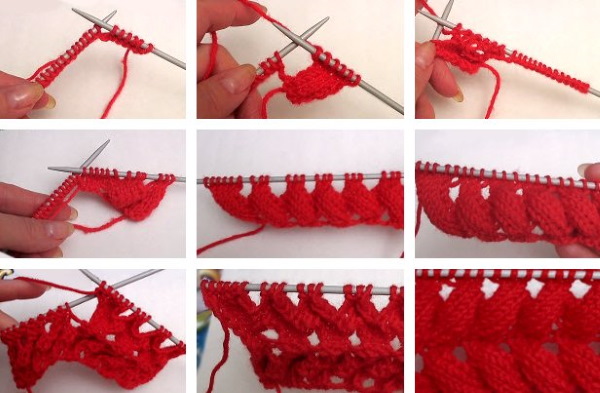
Pattern Description:
- 1 row with knit stitches, 2 completely purl stitches, and 3 sectional.
- Next, cast on 8 knit stitches, turn and knit.
- Row 13 is knitted with front loops, and row 14 is knitted with 8 front loops and + 4 front loops from the left knitting needle, repeat until the end of the row.
- Then the sections are combined. A row of purl stitches is knitted on top, then another 1 knit stitch.
- Next, knit a sectional row.
The color of the threads can be any, but a special effect is achieved by combining white and soft blue shades in a gradient.
With a pattern of colored chevrons
Chevrons are wavy stripes with sharp curves. This pattern looks best on garter stitch and stocking stitch.
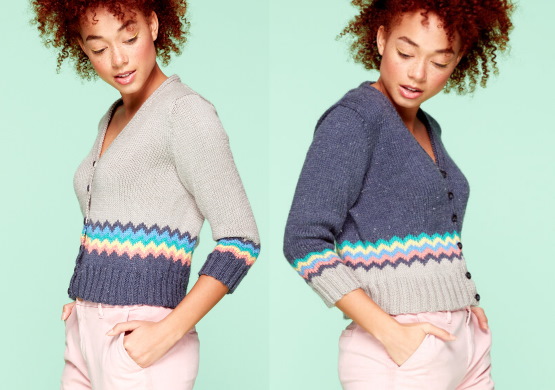
Here it is important to choose the right shade of thread. Chevrons can be bright on a white background, light on a dark background, or smoothly transition into a gradient from dark to light or from bright to color.
It is not difficult to learn how to knit women's cardigans. It is important to choose the right needles and threads, and also to create a small sample with patterns according to diagrams and descriptions for testing before work. This will help to identify problem areas in advance and find a solution.
Video about knitting a cardigan
Cardigan knitting patterns:
